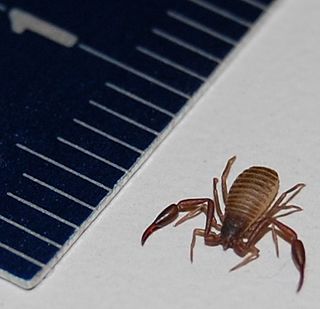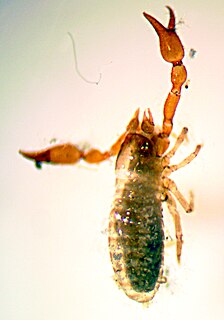
A pseudoscorpion, also known as a false scorpion or book scorpion, is an arachnid belonging to the order Pseudoscorpiones, also known as Pseudoscorpionida or Chelonethida.

Shaggy parasol is the common name for three closely related species of mushroom, Chlorophyllum rhacodes, C. olivieri and C. brunneum, found in North America, Europe and Southern Africa.

Chlorophyllum is a genus of large agarics similar in appearance to the true parasol mushroom. Chlorophyllum was originally coined in 1898, a time when spore color was the deciding factor for differentiating genera. It was termed in order to describe the poisonous green-spored C. molybdites which shared many characteristics of the mushrooms within the genus Lepiota but lacked the all important white spores. The name derives from Greek Chloro meaning green and phyllo meaning leaf. It remained as a monotypic genus until recently when modern DNA analyses concluded that many of the mushrooms contained in the genus Macrolepiota actually had more in common genetically with the Chlorophyllum molybdites than with the other members of the Macrolepiota. The genus has a widespread distribution, with many species found in tropical regions. The best known members are the edible shaggy parasol, a name applied to three very similar species Chlorophyllum rhacodes, C. olivieri and C. brunneum, and the poisonous C. molybdites, which is widespread in subtropical regions around the world.
Sororoditha hirsuta is a species of pseudoscorpion in the family Tridenchthoniidae.
Tridenchthonius africanus is a species of pseudoscorpion in the family Tridenchthoniidae.

Chelifer cancroides, the house pseudoscorpion, is a species of pseudoscorpions. It is a cosmopolitan, synanthropic, and harmless species to humans.
Garypus titanius is a species of pseudoscorpions of the family Garypidae. Individuals of this species may be as large as 12 millimetres (0.47 in) long, making it the largest pseudoscorpion in the world. Garypus titanius is endemic to Boatswain Bird Island, off the coast of Ascension Island, in the British overseas territory of Saint Helena, Ascension and Tristan da Cunha.
Tyrannochthonius rex is a species of pseudoscorpion in the family Chthoniidae.

Epiocheirata is a suborder of pseudoscorpions in the order Pseudoscorpiones. There are about 5 families and at least 740 described species in Epiocheirata.

Microbisium parvulum is a species of pseudoscorpion in the family Neobisiidae.

Microbisium is a genus of pseudoscorpions in the family Neobisiidae. There are about 12 described species in Microbisium.
Syarinus enhuycki is a species of pseudoscorpion in the family Syarinidae.
Syarinus is a genus of pseudoscorpions in the family Syarinidae. There are about six described species in Syarinus.
Illinichernes distinctus is a species of pseudoscorpion in the family Chernetidae.
Illinichernes is a genus of pseudoscorpions in the family Chernetidae. There are at least two described species in Illinichernes.
Siphloplecton is a genus of cleftfooted minnow mayflies in the family Metretopodidae. There are about 15 described species in Siphloplecton.
Garypus californicus is a species of pseudoscorpion in the family Garypidae.

Neobisiinae is a subfamily of pseudoscorpions in the family Neobisiidae.
Chitrella is a genus of pseudoscorpions in the family of Syarinidae.





